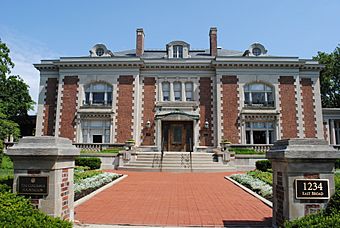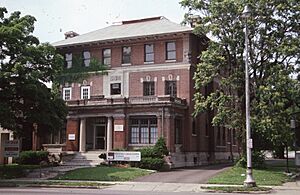Columbus Foundation facts for kids
Quick facts for kids |
|
|
Old Governor's Mansion
|
|
|
U.S. Historic district
Contributing property |
|
 |
|
| Location | 1234 E. Broad St., Columbus, Ohio |
|---|---|
| Area | 6 acres (2.4 ha) |
| Built | 1904 |
| Architect | Frank Packard |
| Architectural style | Colonial Revival, Neo-Georgian eclectic |
| Part of | East Broad Street Historic District |
| MPS | East Broad Street MRA |
| NRHP reference No. | 72001012 |
| Added to NRHP | June 5, 1972 |
The Columbus Foundation is a special group in Columbus, Ohio. It is a nonprofit organization, which means it uses its money to help others, not to make a profit. This foundation was started in 1943.
How the Foundation Started
A Helping Hand for the Community
The Columbus Foundation was created by a person named Harrison M. Sayre. His father was also very involved in helping people in his own town, Newark, Ohio. Harrison Sayre saw how much good his father did. He wanted to do something similar for the community in Columbus.
Working Together to Build Good
Sayre believed that a "community foundation" could really make a difference. This kind of foundation collects money from many people. Then, it uses that money to support different good causes in the area. In December 1943, Sayre and Russell Cole met with leaders from Huntington Bank and City National Bank. Together, they officially started The Columbus Foundation. A few years later, in 1947, the Ohio National Bank also joined in to help.
Remembering a Founder
When Harrison Sayre passed away, many people wanted to honor him. They made about 150 donations to The Columbus Foundation in his memory. This showed how much he meant to the community.
Helping Women and Children
The oldest fund managed by the Foundation was set up a long time ago. It was created by William G. Deshler in the 1880s. He started this fund to remember his daughter and mother, who had both passed away. The money from this fund helps the Columbus Female Benevolent Society. This group works to support women and children in need throughout the Columbus area.
The Foundation's Home
The Historic Old Governor's Mansion
The Columbus Foundation is located in a beautiful old building. It is called the Old Governor's Mansion and can be found at 1234 E. Broad St. This building was constructed in 1904. It is also known by other names, like the Ohio Archives Building or the Charles H. Lindenberg Home.
A Protected Landmark
Because of its history and special design, the Old Governor's Mansion was added to the National Register of Historic Places in 1972. This list includes important buildings and places across the country that are worth protecting. The mansion is also part of a larger area called the East Broad Street Historic District. This district includes many other historic buildings on Broad Street.
Who Designed This Grand Building?
The famous architect Frank Packard designed the mansion. He used a style called Colonial Revival or Neo-Georgian. These styles look back to the grand homes built during America's early history. The property listed on the National Register includes six acres of land and three important buildings.
From Private Home to Governor's Residence
The mansion was first built for Charles H. Lindenberg. He was the president of a company called Lilley Regalia. Later, this grand house became the home for ten different governors of Ohio and their families. They lived there for a total of 36 years.
Changes to the Neighborhood
In 2008, The Columbus Foundation made a decision about a house next door. This house, called the Joseph F. Firestone House, was built around 1900. It had been empty for many years. The foundation thought about saving it. However, they decided it would be too difficult and costly to fix it up for new uses. This house was also part of the East Broad Street Historic District on the National Register of Historic Places. After the house was taken down, the area became a parking lot and a green space.
See Also


